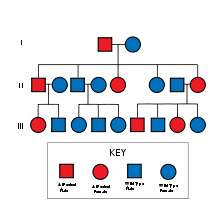- Muenke syndrome
-
Muenke syndrome Classification and external resources OMIM 602849 DiseasesDB 33585 Muenke Syndrome, also known as FGFR3-related craniosynostosis,[1] is a human specific condition characterized by the premature closure of certain bones of the skull during development, which affects the shape of the head and face. Muenke syndrome occurs in about 1 in 30,000 newborns. This condition accounts for an estimated 8 percent of all cases of craniosynostosis.
Contents
Symptoms
Many people with this disorder have a premature fusion of skull bones along the coronal suture. Other parts of the skull may be malformed as well. This will usually cause an abnormally shaped head, wide-set eyes, and flattened cheekbones in these patients. About 5 percent of affected individuals have an enlarged head (macrocephaly).There may also be associated hearing loss in 10 - 30% of cases and it is important for affected individuals to have hearing tests to check on the possibility of a problem.
Most people with this condition have normal intellect, but developmental delay and learning disabilities are possible. The signs and symptoms of Muenke syndrome vary among affected people, and some findings overlap with those seen in other craniosynostosis syndromes. Between 6 percent and 7 percent of people with the gene mutation associated with Muenke syndrome do not have any of the characteristic features of the disorder.
Genetics
Muenke Syndrome is inherited in an autosomal dominant pattern. In some cases, an affected person inherits the mutation from one affected parent. Other cases may result from new mutations in the gene. These cases occur in people with no history of the disorder in their family.
A single mutation in the FGFR3 gene cause this syndrome. The FGFR3 gene provides instructions for making a protein that is involved in the development and maintenance of bone and brain tissue. This mutation causes the FGFR3 protein to be overly active, which interferes with normal bone growth and allows the bones of the skull to fuse before they should.
References
- ^ Clinical Study of Muenke Syndrome (FGFR3-Related Craniosynostosis). Clinicaltrials.gov. December 12, 2006, accessed February 7, 2007.
- Rannan-Eliya, SV; Taylor, IB; De Heer, IM; Van den Ouweland, AMW; Wall, SA; Wilkie, AOM. Paternal Origin of FGFR3 Mutations in Muenke-Type Craniosynostosis. Hum. Genet. 115: 200-207, 2004. PMID 15241680.
External links
- National Institute of Health's Reference
- GeneReview/NIH/UW entry on Muenke Syndrome
- Supra Regional Hospitals' Muenke Syndrome Resource (UK)
Categories:- Congenital disorders
- Cell surface receptor deficiencies
- Neurological disorders
Wikimedia Foundation. 2010.

